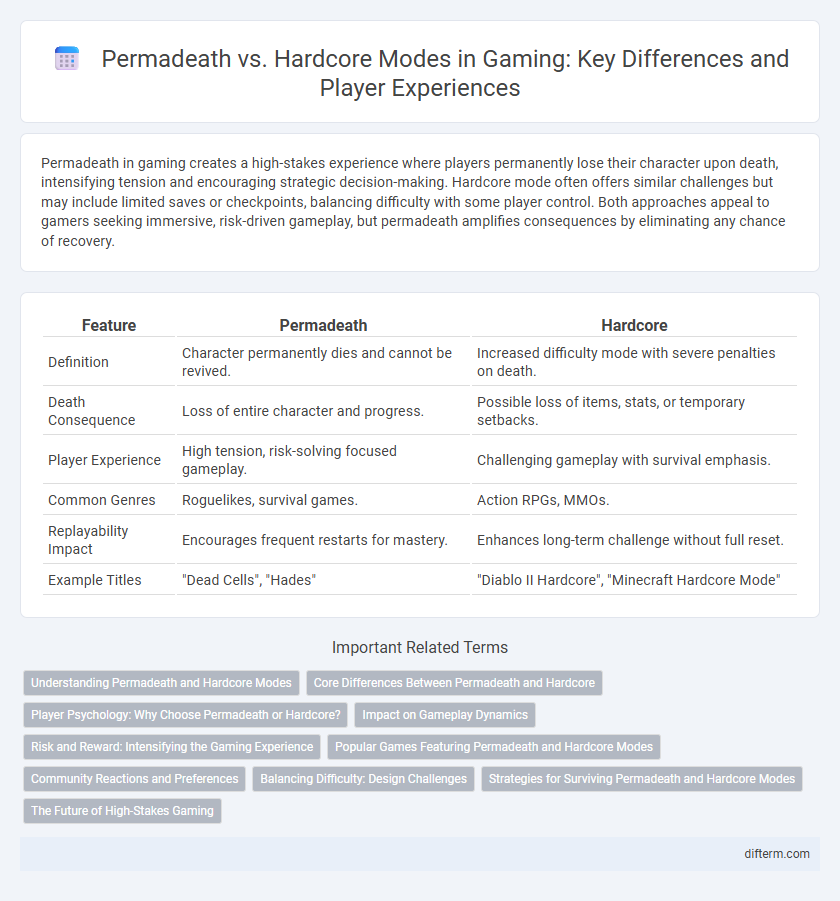Permadeath in gaming creates a high-stakes experience where players permanently lose their character upon death, intensifying tension and encouraging strategic decision-making. Hardcore mode often offers similar challenges but may include limited saves or checkpoints, balancing difficulty with some player control. Both approaches appeal to gamers seeking immersive, risk-driven gameplay, but permadeath amplifies consequences by eliminating any chance of recovery.
Table of Comparison
| Feature | Permadeath | Hardcore |
|---|---|---|
| Definition | Character permanently dies and cannot be revived. | Increased difficulty mode with severe penalties on death. |
| Death Consequence | Loss of entire character and progress. | Possible loss of items, stats, or temporary setbacks. |
| Player Experience | High tension, risk-solving focused gameplay. | Challenging gameplay with survival emphasis. |
| Common Genres | Roguelikes, survival games. | Action RPGs, MMOs. |
| Replayability Impact | Encourages frequent restarts for mastery. | Enhances long-term challenge without full reset. |
| Example Titles | "Dead Cells", "Hades" | "Diablo II Hardcore", "Minecraft Hardcore Mode" |
Understanding Permadeath and Hardcore Modes
Permadeath mode in gaming means that once a player's character dies, all progress is permanently lost, creating a high-stakes experience that demands careful decision-making. Hardcore mode often involves increased game difficulty, limited saves, or consequences for death, but may allow some form of resurrection or progress retention. Understanding the distinction helps players choose between the intense finality of permadeath and the challenging but potentially forgiving nature of hardcore gameplay.
Core Differences Between Permadeath and Hardcore
Permadeath enforces a permanent loss of a character upon death, requiring players to restart from the beginning, while Hardcore mode typically restricts respawns but may allow continuation with a new character or limited saves. Permadeath increases stakes by eliminating any chance of recovery, intensifying tension and strategic decision-making. Hardcore gameplay balances challenge with progress retention, often appealing to players seeking high difficulty without complete character erasure.
Player Psychology: Why Choose Permadeath or Hardcore?
Permadeath and Hardcore modes appeal to players seeking intense emotional engagement and heightened stakes, triggering adrenaline and risk-reward decision-making processes. Permadeath evokes deep attachment and fear of loss by making character death permanent, fostering careful strategy and immersion. Hardcore mode balances challenge with continued progress, satisfying players' desire for achievement and resilience without losing all progress, reinforcing motivation and perseverance.
Impact on Gameplay Dynamics
Permadeath drastically elevates tension and player investment by permanently removing characters upon death, forcing strategic decision-making and often slower, more cautious gameplay. Hardcore modes, while punishing with limited lives or harsher penalties, typically allow for character recovery or progression retention, balancing risk with sustained engagement. These mechanics redefine pacing and player behavior, shifting the focus toward survival strategy and heightening emotional stakes in gaming dynamics.
Risk and Reward: Intensifying the Gaming Experience
Permadeath in gaming exponentially raises the stakes by eliminating character revival, creating an intense risk that heightens player commitment and strategic planning. Hardcore modes amplify this experience by enforcing stringent penalties, rewarding precision and careful resource management with greater in-game achievements. This risk-reward dynamic intensifies immersion, making each decision critical and elevating the overall gaming experience.
Popular Games Featuring Permadeath and Hardcore Modes
Popular games featuring permadeath and hardcore modes include "Darkest Dungeon," where permanent character loss intensifies strategic gameplay, and "The Binding of Isaac," offering roguelike replayability with high stakes. "DayZ" provides a hardcore survival experience emphasizing scarcity and risk, while "Dead Cells" blends fast-paced combat with permadeath to challenge player skill and progression. These titles exemplify how permadeath and hardcore modes enhance immersion and player investment by increasing difficulty and consequence.
Community Reactions and Preferences
Community reactions to permadeath and hardcore modes in gaming reveal a clear divide: permadeath garners admiration for heightening tension and authenticity, attracting players who value high stakes and permanent consequences. Hardcore modes appeal to competitive gamers seeking a challenging experience with some room for recovery, fostering a dedicated community that values skill progression and perseverance. Data from gaming forums and surveys indicate permadeath players often emphasize emotional investment, while hardcore enthusiasts prioritize mastery and resilience.
Balancing Difficulty: Design Challenges
Balancing difficulty in games with permadeath and hardcore modes requires careful calibration to maintain player engagement without causing frustration. Developers must design mechanics that offer meaningful consequences for failure while ensuring progression remains rewarding and skill-based. Achieving this balance involves integrating adaptive challenges and risk-reward systems that cater to diverse player skill levels.
Strategies for Surviving Permadeath and Hardcore Modes
Effective survival strategies in permadeath and hardcore gaming modes include meticulous resource management, prioritizing stealth over confrontation to reduce risk, and mastering environmental awareness to anticipate threats. Players benefit from developing adaptive tactics, such as saving progress frequently when possible and learning enemy patterns to avoid fatal mistakes. Emphasizing patience and strategic planning enhances longevity and success in these high-risk gaming scenarios.
The Future of High-Stakes Gaming
Permadeath and hardcore modes are reshaping the future of high-stakes gaming by intensifying player commitment and emotional investment. As game developers integrate advanced AI and procedural generation, survival experiences become increasingly unpredictable and challenging, elevating replayability. Emerging VR technology further amplifies immersion, making each decision in permadeath scenarios critically consequential for long-term player engagement.
Permadeath vs Hardcore Infographic

 difterm.com
difterm.com